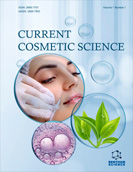Abstract
Background: To produce alternative hydrophilic patterns on the surface of a nanocomposite, many different approaches have been used. The ionic liquid (IL) microemulsions expanding the potential uses of ILs that can provide hydrophilic or hydrophobic nanodomains as a nanoreactor to the synthesis of a novel type of nanocomposites with special properties.
Objective: This study aims to investigate photo-induced hydrophilicity of modified poly(methyl methacrylate) (PMMA) containing TiO2 nanoparticles, synthesized by using ionic liquid-in-oil microemulsion system.
Materials and Methods: A series of visible light-responsive PMMA/TiO2 nanocomposite films were prepared in an ionic liquid (IL) based microemulsion containing methyl methacrylate monomer, 1- buthyl-3-methylimidazolium tetrafluoroborate ([bmim][BF4]), Triton X-100 and 1-buthanol. The ternary phase diagram of the microemulsion system has been constructed and concluded that it is thermodynamically stable at polymerization temperature of 60°C. The oil phase of the system was polymerized to obtain the PMMA nanocomposite films with different concentration of TiO2 nanoparticles. Techniques such as XRD, AFM and TEM were carried out to characterize the fabricated transparent nanocomposite films. The visible light photo-induced hydrophilicity of the prepared PMMA/IL/TiO2 films was evaluated by measuring the contact angle of water on a thin film of the nanocomposite during the visible light illumination.
Results: The results showed that the surface hydrophilicity of the nanocomposites will be changed significantly with light illumination and the PMMA/IL with 0.01 wt.% loading of TiO2 showed the best hydrophilicity. The contact angle of the nanocomposite was decreased with increasing of irradiation time and from that, the surface energy and work of adhesion increased.
Conclusion: It is concluded that modification of TiO2 nanoparticles with ionic liquid is a new approach for making visible light photo-induced polymer nanocomposites with improved hydrophilicity performance.
Keywords: Hydrophilicity, ionic liquid, microemulsion, nanocomposite, poly(methyl methacrylate), TiO2.
Graphical Abstract














